ASUS RS100-E5-PI2 User Manual
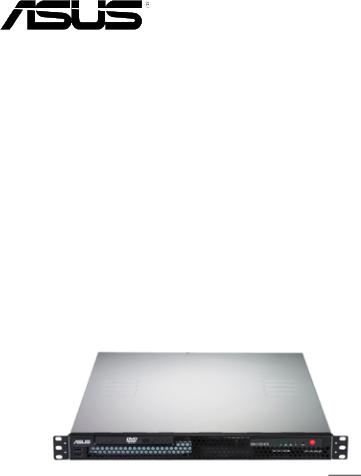
RS100-E5-PI2
1U Rackmount Server
User Guide

E3648
First Edition V1
March 2008
Copyright 2008© ASUSTeK COMPUTER INC. All Rights Reserved.
No part of this manual, including the products and software described in it, may be reproduced, transmitted, transcribed, stored in a retrieval system, or translated into any language in any form or by any means, except documentation kept by the purchaser for backup purposes, without the express written permission of ASUSTeK COMPUTER INC. (“ASUS”).
ASUS provides this manual “as is” without warranty of any kind, either express or implied, including but not limited to the implied warranties or conditions of merchantability or fitness for a particular purpose. In no event shall ASUS, its directors, officers, employees, or agents be liable for any indirect, special, incidental, or consequential damages (including damages for loss of profits, loss of business, loss of use or data, interruption of business and the like), even if ASUS has been advised of the possibility of such damages arising from any defect or error in this manual or product.
Specifications and information contained in this manual ae furnished for informational use only, and are subject to change at any time without notice, and should not be construed as a commitment by ASUS. ASUS assumes no responsibility or liability for any errors or inaccuracies that may appear in this manual, including the products and software described in it.
Product warranty or service will not be extended if: (1) the product is repaired, modified or altered, unless such repair, modification of alteration is authorized in writing by ASUS; or (2) the serial number of the product is defaced or missing.
Products and corporate names appearing in this manual may or may not be registered trademarks or copyrights of their respective companies, and are used only for identification or explanation and to the owners’ benefit, without intent to infringe.
ii

Contents
Contents....................................................................................................... |
iii |
Notices........................................................................................................ |
vii |
Safety information..................................................................................... |
viii |
About this guide.......................................................................................... |
ix |
Chapter 1: |
Product introduction |
|
|
1.1 |
System package contents............................................................ |
1-2 |
|
1.2 |
Serial number label....................................................................... |
1-2 |
|
1.3 |
System specifications.................................................................. |
1-3 |
|
1.4 |
Front panel features..................................................................... |
1-5 |
|
1.5 |
Rear panel features...................................................................... |
1-5 |
|
1.6 |
Internal features............................................................................ |
1-6 |
|
1.7 |
LED information............................................................................ |
1-7 |
|
|
1.7.1 |
Front panel LEDs............................................................. |
1-7 |
|
1.7.2 |
LAN (RJ-45) LEDs........................................................... |
1-7 |
Chapter 2: |
Hardware setup |
|
|
2.1 |
Chassis cover............................................................................... |
2-2 |
|
|
2.1.1 |
Removing the cover......................................................... |
2-2 |
|
2.1.2 |
Installing the cover........................................................... |
2-3 |
2.2 |
Motherboard information............................................................. |
2-5 |
|
2.3 |
Central Processing Unit (CPU).................................................... |
2-6 |
|
|
2.3.1 |
Installing the CPU............................................................ |
2-6 |
|
2.3.2 |
Installing the CPU heatsink............................................. |
2-8 |
2.4 |
System memory.......................................................................... |
2-10 |
|
|
2.4.1 |
Overview........................................................................ |
2-10 |
|
2.4.2 |
Memory configurations.................................................. |
2-10 |
|
2.4.3 |
Installing a DIMM............................................................ |
2-11 |
|
2.4.4 |
Removing a DIMM.......................................................... |
2-11 |
2.5 |
Replaceable components.......................................................... |
2-12 |
|
|
2.5.1 |
Installing the chassis fans.............................................. |
2-12 |
|
2.5.2 |
Installing Serial ATA drives............................................. |
2-13 |
|
2.5.3 |
Installing optical disk drive (ODD)................................. |
2-17 |
Chapter 3: |
Installation options |
|
|
3.1 |
Rackmount rail kit items.............................................................. |
3-2 |
|
iii

Contents
|
3.1.1 |
Attaching the rack ears.................................................... |
3-2 |
|
3.1.2 |
Attaching the rails to the rack.......................................... |
3-3 |
3.2 |
Rackmount bracket kit (Optional)............................................... |
3-7 |
|
|
3.2.1 |
Attaching the long rack ears............................................ |
3-7 |
|
3.2.2 |
Attaching the server to the rack cabinet.......................... |
3-8 |
3.3 |
Front panel cover kit (Optional).................................................. |
3-9 |
|
Chapter 4: |
Motherboard information |
|
|
4.1 |
Motherboard overview................................................................. |
4-2 |
|
|
Layout contents.............................................................................. |
4-3 |
|
4.2 |
Jumpers |
......................................................................................... |
4-4 |
4.3 |
Connectors.................................................................................... |
4-7 |
|
|
4.3.1 .................................................... |
Rear panel connectors |
4-7 |
|
4.3.2 .......................................................... |
Internal connectors |
4-8 |
Chapter 5: |
BIOS setup |
|
|
5.1 |
Managing and updating your BIOS............................................. |
5-2 |
|
|
5.1.1 |
Creating a bootable floppy disk....................................... |
5-2 |
|
5.1.2 |
AFUDOS utility................................................................ |
5-3 |
|
5.1.3 |
ASUS CrashFree BIOS 3 utility....................................... |
5-6 |
5.2 |
BIOS setup program..................................................................... |
5-8 |
|
|
5.2.1 |
BIOS menu screen.......................................................... |
5-9 |
|
5.2.2 |
Menu bar......................................................................... |
5-9 |
|
5.2.3 |
Navigation keys............................................................... |
5-9 |
|
5.2.4 |
Menu items.................................................................... |
5-10 |
|
5.2.5 |
Sub-menu items............................................................ |
5-10 |
|
5.2.6 |
Configuration fields........................................................ |
5-10 |
|
5.2.7 |
Pop-up window.............................................................. |
5-10 |
|
5.2.8 |
Scroll bar....................................................................... |
5-10 |
|
5.2.9 |
General help.................................................................. |
5-10 |
5.3 |
Main menu................................................................................... |
5-11 |
|
|
5.3.1 |
System Time................................................................... |
5-11 |
|
5.3.2 |
System Date................................................................... |
5-11 |
|
5.3.3 |
Legacy Diskette A........................................................... |
5-11 |
|
5.3.4 |
Primary IDE Master/Slave, SATA1-4............................. |
5-12 |
|
5.3.5 |
IDE Configuration.......................................................... |
5-13 |
iv

Contents
|
5.3.6 |
System Information........................................................ |
5-15 |
5.4 |
Advanced menu.......................................................................... |
5-16 |
|
|
5.4.1 |
USB Configuration......................................................... |
5-16 |
|
5.4.2 |
Remote Access Configuration....................................... |
5-17 |
|
5.4.3 |
Trusted Computing........................................................ |
5-18 |
|
5.4.4 |
MPS Configuration........................................................ |
5-18 |
|
5.4.5 |
CPU Configuration......................................................... |
5-19 |
|
5.4.6 |
Chipset Configuration.................................................... |
5-20 |
|
5.4.7 |
Onboard Devices Configuration.................................... |
5-21 |
|
5.4.8 |
PCI PnP......................................................................... |
5-22 |
5.5 |
Power Configuration.................................................................. |
5-24 |
|
|
5.5.1 |
APM Configuration........................................................ |
5-25 |
|
5.5.2 |
Hardware Monitor.......................................................... |
5-26 |
5.6 |
Boot menu................................................................................... |
5-28 |
|
|
5.6.1 |
Boot Device Priority....................................................... |
5-28 |
|
5.6.2 |
Boot Settings Configuration........................................... |
5-29 |
|
5.6.3 |
Security.......................................................................... |
5-30 |
5.7 |
Exit menu..................................................................................... |
5-32 |
|
Chapter 6: |
RAID configuration |
|
|
6.1 |
RAID configurations..................................................................... |
6-2 |
|
|
6.1.1 |
RAID definitions............................................................... |
6-2 |
|
6.1.2 |
Installing Serial ATA hard disks........................................ |
6-3 |
|
6.1.3 |
Setting the RAID item in BIOS......................................... |
6-3 |
|
6.1.4 |
RAID configuration utility................................................. |
6-3 |
6.2 |
Intel® Matrix Storage Manager Option ROM Utility.................... |
6-4 |
|
|
6.2.1 |
Creating a RAID 0 set (striped)....................................... |
6-5 |
|
6.2.2 |
Creating a RAID 1 set (mirrored)..................................... |
6-6 |
|
6.2.3 |
Deleting a RAID set......................................................... |
6-7 |
|
6.2.4 |
Resetting Disks to Non-RAID.......................................... |
6-8 |
|
6.2.5 |
Exiting the Intel® Matrix Storage Manager utility.............. |
6-8 |
|
6.2.6 |
Rebuilding the RAID........................................................ |
6-9 |
|
6.2.7 |
Setting the Boot array in the BIOS Setup Utility............ |
6-10 |
6.3 |
LSI Software RAID Configuration Utility................................... |
6-11 |
|
|
6.3.1 |
Creating a RAID 0 or RAID 1 set................................... |
6-12 |

Contents
|
6.3.2 |
Initializing the virtual drives............................................ |
6-18 |
|
6.3.3 |
Rebuilding failed drives................................................. |
6-23 |
|
6.3.4 |
Checking the drives for data consistency...................... |
6-25 |
|
6.3.5 |
Deleting a RAID configuration....................................... |
6-28 |
|
6.3.6 |
Selecting the boot drive from a RAID set...................... |
6-29 |
|
6.3.7 |
Enabling the WriteCache............................................... |
6-30 |
Chapter 7: |
Driver installation |
|
|
7.1 |
RAID driver installation................................................................ |
7-2 |
|
|
7.1.1 |
Creating a RAID driver disk............................................. |
7-2 |
|
7.1.2 |
Installing the RAID controller driver................................. |
7-4 |
7.2 |
LAN driver installation............................................................... |
7-14 |
|
|
7.2.1 |
Windows® Server........................................................... |
7-14 |
|
7.2.2 |
Red Hat® Enterprise....................................................... |
7-15 |
7.3 |
VGA driver installation............................................................... |
7-16 |
|
|
7.3.1 |
Windows® Server........................................................... |
7-16 |
|
7.3.2 |
Red Hat enterprise........................................................ |
7-17 |
7.4 |
Management applications and utilities installation................. |
7-18 |
|
|
7.4.1 |
Running the support CD................................................ |
7-18 |
|
7.4.2 |
Drivers menu................................................................. |
7-18 |
|
7.4.3 |
Management Software menu........................................ |
7-19 |
|
7.4.4 |
Utilities menu................................................................. |
7-19 |
|
7.4.5 |
Contact information....................................................... |
7-20 |
Appendix: |
Reference information |
|
|
A.1 |
Intel® EM64T.................................................................................. |
A-2 |
|
|
Using the Intel® EM64T feature...................................................... |
A-2 |
|
A.2 |
Enhanced Intel SpeedStep® Technology (EIST)......................... |
A-2 |
|
|
A.2.1 |
System requirements....................................................... |
A-2 |
|
A.2.2 |
Using the EIST................................................................. |
A-3 |
vi
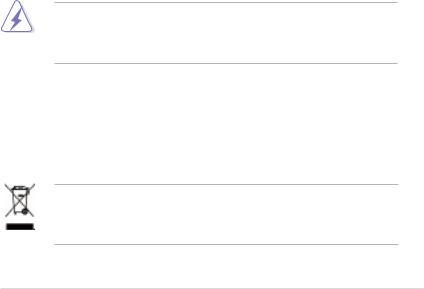
Notices
Federal Communications Commission Statement
This device complies with Part 15 of the FCC Rules. Operation is subject to the following two conditions:
•This device may not cause harmful interference, and
•This device must accept any interference received including interference that may cause undesired operation.
This equipment has been tested and found to comply with the limits for a
Class B digital device, pursuant to Part 15 of the FCC Rules. These limits are designed to provide reasonable protection against harmful interference in a residential installation. This equipment generates, uses and can radiate radio frequency energy and, if not installed and used in accordance with manufacturer’ s instructions, may cause harmful interference to radio communications. However, there is no guarantee that interference will not occur in a particular installation. If this equipment does cause harmful interference to radio or television reception, which can be determined by turning the equipment off and on, the user is encouraged to try to correct the interference by one or more of the following measures:
•Reorient or relocate the receiving antenna.
•Increase the separation between the equipment and receiver.
•Connect the equipment to an outlet on a circuit different from that to which the receiver is connected.
•Consult the dealer or an experienced radio/TV technician for help.
WARNING! The use of shielded cables for connection of the monitor to the graphics card is required to assure compliance with FCC regulations. Changes or modifications to this unit not expressly approved by the party responsible for compliance could void the user’s authority to operate this equipment.
Canadian Department of Communications Statement
This digital apparatus does not exceed the Class B limits for radio noise emissions from digital apparatus set out in the Radio Interference Regulations of the Canadian Department of Communications.
This Class B digital apparatus complies with Canadian ICES-003.
This symbol of the crossed out wheeled bin indicates that the product (electrical, electronic equipment and mercury-containing button cell battery) should not
be placed in municipal waste. Check local regulations for disposal of electronic products.
vii

Safety information
Electrical Safety
•Before installing or removing signal cables, ensure that the power cables for the system unit and all attached devices are unplugged.
•To prevent electrical shock hazard, disconnect the power cable from the electrical outlet before relocating the system.
•When adding or removing any additional devices to or from the system, ensure that the power cables for the devices are unplugged before the signal cables are connected. If possible, disconnect all power cables from the existing system before you add a device.
•If the power supply is broken, do not try to fix it by yourself. Contact a qualified service technician or your dealer.
Operation Safety
•Any mechanical operation on this server must be conducted by certified or experienced engineers.
•Before operating the server, carefully read all the manuals included with the server package.
•Before using the server, make sure all cables are correctly connected and the power cables are not damaged. If any damage is detected, contact your dealer as soon as possible.
•To avoid short circuits, keep paper clips, screws, and staples away from connectors, slots, sockets and circuitry.
•Avoid dust, humidity, and temperature extremes. Place the server on a stable surface.
This product is equipped with a three-wire power cable and plug for the user’s safety. Use the power cable with a properly grounded electrical outlet to avoid electrical shock.
 Lithium-Ion Battery Warning
Lithium-Ion Battery Warning  CAUTION! Danger of explosion if battery is incorrectly replaced.
CAUTION! Danger of explosion if battery is incorrectly replaced.
Replace only with the same or equivalent type recommended by the manufacturer. Dispose of used batteries according to the manufacturer’s instructions.
CD-ROM Drive Safety Warning
CLASS 1 LASER PRODUCT
 Heavy System
Heavy System  CAUTION! This server system is heavy. Ask for assistance when moving or carrying the system.
CAUTION! This server system is heavy. Ask for assistance when moving or carrying the system.
viii

About this guide
Audience
This user guide is intended for system integrators, and experienced users with at least basic knowledge of configuring a server.
Contents
This guide contains the following parts:
1.Chapter 1: Product Introduction
This chapter describes the general features of the server, including sections on front panel and rear panel specifications.
2.Chapter 2: Hardware setup
This chapter lists the hardware setup procedures that you have to perform when installing or removing system components.
3.Chapter 3: Installation options
This chapter describes how to install optional components into the barebone server.
4.Chapter 4: Motherboard information
This chapter gives information about the motherboard that comes with the server. This chapter includes the motherboard layout, jumper settings, and connector locations.
5.Chapter 5: BIOS information
This chapter tells how to change system settings through the BIOS Setup menus and describes the BIOS parameters.
6.Chapter 6: RAID configuration
This chapter tells how to change system settings through the BIOS Setup menus. Detailed descriptions of the BIOS parameters are also provided.
7Chapter 7: Driver installation
This chapter provides instructions for installing the necessary drivers for different system components.
8.Appendix: Reference information
This appendix includes additional information that you may refer to when configuring the motherboard.
ix

Conventions
To make sure that you perform certain tasks properly, take note of the following symbols used throughout this manual.
DANGER/WARNING: Information to prevent injury to yourself when trying to complete a task.
CAUTION: Information to prevent damage to the components when trying to complete a task.
IMPORTANT: Instructions that you MUST follow to complete a task.
NOTE: Tips and additional information to help you complete a task.
Typography
Bold text |
Indicates a menu or an item to select. |
Italics |
Used to emphasize a word or a phrase. |
<Key> |
Keys enclosed in the less-than and greater |
|
than sign means that you must press the |
|
enclosed key. |
|
Example: <Enter> means that you must press |
|
the Enter or Return key. |
<Key1>+<Key2>+<Key3> |
If you must press two or more keys |
|
simultaneously, the key names are linked with |
|
a plus sign (+). |
|
Example: <Ctrl>+<Alt>+<Delete> |
Command |
Means that you must type the command |
|
exactly as shown, then supply the required |
|
item or value enclosed in brackets. |
|
Example: At the DOS prompt, type the |
|
command line: format A:/S |
References |
|
Refer to the following sources for additional information, and for product and software updates.
1.ASUS Server Web-based Management (ASWM) user guide
This manual tells how to set up and use the proprietary ASUS server management utility.
2.ASUS websites
The ASUS websites worldwide provide updated information for all ASUS hardware and software products. Refer to the ASUS contact information.

Chapter 1
This chapter describes the general features of the chassis kit. It includes sections on front panel and rear panel specifications.
ASUS RS100-E5-PI2
Product introduction
1-

1.1System package contents
Check your system package for the following items.
Model Name |
RS100-E5-PI2 |
Chassis |
ASUS R09 1U Rackmount Chassis |
Motherboard |
ASUS P5BV-M/RS100-E5 Server Board |
Component |
1 x 220W 80+ Single Power Supply |
|
2 x SATA Cables |
|
1 x PCI Express x16 Riser Card (x8 link) |
|
1 x Front I/O Board (ASUS FPB-R9) |
|
1 x USB Board (ASUS USB-R9) |
|
2 x System Fans (2 x 40x28) |
Accessories |
1 x CPU Heatsink |
|
1 x RS100-E5-PI2 User’s Guide |
|
1 x ASUS ASWM 2.0 User’s Guide |
|
1 x RS100-E5-PI2 Support CD (including ASWM*) |
|
1 x Bag of Screws |
|
1 x AC Power Cable |
Optional Items Rackmount Rail Kit
Slim-type Optical Device
CA eTrust Anti-virus Software CD
*ASUS System Web-based Management
If any of the above items is damaged or missing, contact your retailer.
1.2Serial number label
Before requesting support from the ASUS Technical Support team, you must take note of the product’s serial number containing 12 characters such as xxxxxxxxxxxx. See the figure below.
With the correct serial number of the product, ASUS Technical Support team members can then offer a quicker and satisfying solution to your problems.
RS100-E5-PI2
xxxxxxxxxxxx
1-2 |
Chapter 1: Product introduction |
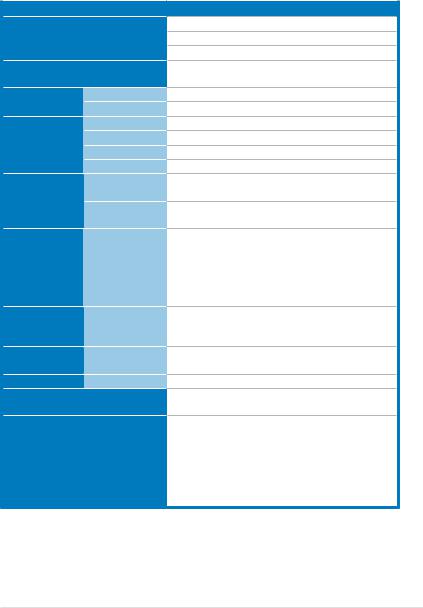
1.3System specifications
The ASUS RS100-E5-PI2 is a 1U barebone server system featuring the ASUS P5BV-M/RS100-E5 server board. The server supports Intel® LGA775 Xeon® 3300/3200/3100/3000 Series processors with EM64T technology, plus other latest technologies through the chipsets onboard.
Model Name
Processor / System Bus
Core Logic
ASUS Features |
Smart Fan |
|
ASWM2.0 |
||
|
|
Total Slots |
|
Memory |
Capacity |
|
Memory Type |
||
|
||
|
Memory Size |
Total PCI/PCI-X/
Expansion Slots PCI-E Slots
Slot Type
Storage |
SATA Controller |
|
|
I = internal HDD Bays A or S will be
hot-swappable
Networking LAN
Graphic VGA
Auxiliary Storage FDD / CD / DVD
Onboard I/O
RS100-E5-PI2
1 x Socket LGA775
Intel® Xeon® 3300/3200/3100/3000 Series CPU
FSB 1333/1066/800
Intel® 3200 MCH
Intel® ICH7R
Smart Fan III
√
4 (Dual-Channel)
Maximum up to 8GB
DDR2 800/667 Unbuffered ECC/Non-ECC DIMM
512MB, 1GB and 2GB
1
1 x PCI-E x16 slot (x8 link) (Full-Height/Half-
Length)
Intel® ICH7R:
2 x SATA2 300MB/s ports*
Intel Matrix Storage (for Windows only)
-Supports software RAID 0 & 1 LSI MegaRAID (for Linux/Windows)
-Supports software RAID 0 & 1
2 x Internal SATA2 HDD Bays
2 x Broadcom® BCM5721 PCI-E GbE LAN
- Supports 10/100/1000 Mbps transfer rates
XGI® Volari Z9s + 32MB
1 x Slim-type Optical Device Bay
Options: No Device / DVD-ROM / DVD-RW
1 x External Serial Port
3 x RJ-45 ports (2 for GbE and 1 for optional ASMB3-iKVM)
4 x USB 2.0 ports (Front x 2, Rear x 2) 1 x VGA port
1 x PS/2 keyboard port
1 x PS/2 mouse port
(continued on the next page)
ASUS RS100-E5-PI2 |
1-3 |

Anti-virus Software
Management |
Hardware |
Solution |
Software |
Dimension (D x W x H)
Net Weight Kg (CPU, DRAM & HDD not inclu ded)
Power Supply
Environment
CA® eTrust™ anti-virus software (Optional)
SM-Bus/ASMB3-SOL or ASMB3-iKVM (Optional)
ASUS ASWM 2.0®
381mm x 430mm x 43.4mm
6.2 Kg
220W 80+ PFC PSU
Operation temperature: 10°C ~ 35°C / Non operation temperature: -40°C ~ 70°C
Non operation humidity: 20% ~ 90% ( Noncondensing)
*Specifications are subject to change without notice.
1-4 |
Chapter 1: Product introduction |
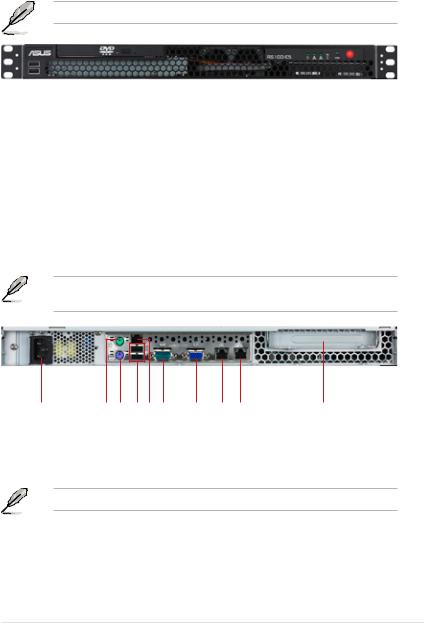
1.4Front panel features
The barebone server displays a simple yet stylish front panel with easily accessible features. The power and reset buttons, LED indicators, optical drive, and two USB ports are located on the front panel.
Refer to section 1.6.1 Front panel LEDs for the LED descriptions.
|
|
|
|
|
|
HDD Access LED |
|
|
|
|
|
|
|
|
||
|
|
|
|
|
|
|
|
|
|
|
|
|
|
|||
|
|
|
|
|
|
|
|
|
|
|
|
|
|
|||
|
|
|
|
|
|
|
|
|
|
|
|
|
|
|||
|
|
|
|
|
|
LAN2 LED |
|
|
|
|
|
|
|
|
|
|
USB 2.0 ports |
Optical drive |
LAN1 LED |
|
|
|
|
|
|
|
|
Power |
|||||
|
|
|
|
|
|
|
|
|
|
|
||||||
|
|
|
|
|
|
Power LED |
|
|
|
|
|
|
|
|
button |
|
|
|
|
|
|
|
|
|
Reset |
|
button |
||||||
|
|
|
|
|
|
|
|
|
|
|
||||||
1.5Rear panel features
The rear panel includes the expansion slots, and system power socket. The middle part includes the I/O shield with openings for the rear panel connectors on the motherboard.
The ports for the PS/2 keyboard, PS/2 mouse, USB, VGA, and Gigabit LAN do not appear on the rear panel if motherboard is not present.
socket power AC |
port Serial port* iKVM ports 0.2 USB port keyboard PS/2 port mouse PS/2 |
port VGA |
(SOL 1 port LAN LAN) Shared 2 port LAN |
slot Expansion |
*This port is for ASUS ASMB3-SOL or ASMB3-iKVM controller card only.
ASUS RS100-E5-PI2 |
1-5 |
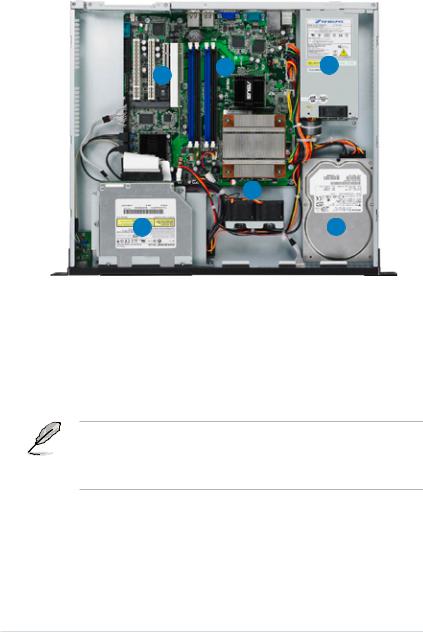
1.6Internal features
The barebone server includes the basic components as shown.
1 |
3 |
4 |
|
|
2
5 |
6 |
1.PCI Express x16 Riser Card (at x8 link)
2.Chassis fans (x 2)
3.ASUS P5BV-M/RS100-E5 Server Board
4.Power supply
5.HDD tray 2 (hidden) and Slim-type Optical drive (optional)
6.HDD tray 1
• The barebone server does not include a floppy disk drive. connect a USB floppy disk drive to any of the USB ports on the front or rear panel if you need to use a floppy disk.
•Only ASUS CD/DVD-ROMs fit the optical drive bay.
1-6 |
Chapter 1: Product introduction |

1.7LED information
1.7.1Front panel LEDs
|
|
|
|
|
|
|
|
|
|
|
|
|
|
|
|
|
|
|
|
|
HDD Access LED |
|
|
|
|
|
Power LED |
||
|
|
|
|
|
|
||||
|
|
LAN2 LED |
|
|
|
|
|||
|
|
|
|
|
|
||||
|
|
|
|
LAN1 LED |
|||||
|
|
|
|
|
|
|
|
|
|
LED |
Icon |
Display status |
Description |
||||||
Power LED |
|
ON |
System power ON |
||||||
HDD Access LED |
|
OFF |
No activity |
||||||
|
Blinking |
Read/write data into the HDD |
|||||||
|
|
||||||||
|
|
OFF |
No LAN connection |
||||||
LAN LEDs |
|
Blinking |
LAN is transmitting or receiving data |
||||||
|
|
ON |
LAN connection is present |
||||||
1.7.2LAN (RJ-45) LEDs
|
|
|
|
|
|
|
|
|
SPEED LED |
|
|
|
|
|
|
|
|
|
|
|
|
|
|
|
|
|
|
|
ACT/LINK LED |
|
|
|
|
|
|
|
|
|
|
|
|
|
|
|
|
|
|
|
|
|
|
|
|
|
|
|
|
|
|
|
|
|
|
|
|
|
|
|
|
ACT/LINK LED |
SPEED LED |
|
|||||||
Status |
Description |
Status |
Description |
||||||
OFF |
No link |
OFF |
10 Mbps connection |
||||||
GREEN |
Linked |
ORANGE |
100 Mbps connection |
||||||
BLINKING |
Data activity |
GREEN |
1 Gbps connection |
||||||
ASUS RS100-E5-PI2 |
1-7 |

1-8 |
Chapter 1: Product introduction |

Chapter 2
This chapter lists the hardware setup procedures that you have to perform when installing or removing system components.
ASUS RS100-E5-PI2
Hardware setup
2-

2.1Chassis cover
2.1.1Removing the cover
1.Use a Phillips screwdriver to remove the screw on the top cover.
2.Firmly hold the cover and slide it toward the rear panel for about half an inch until it is disengaged from the chassis.
3.Lift the cover from the chassis.
2-2 |
Chapter 2: Hardware setup |
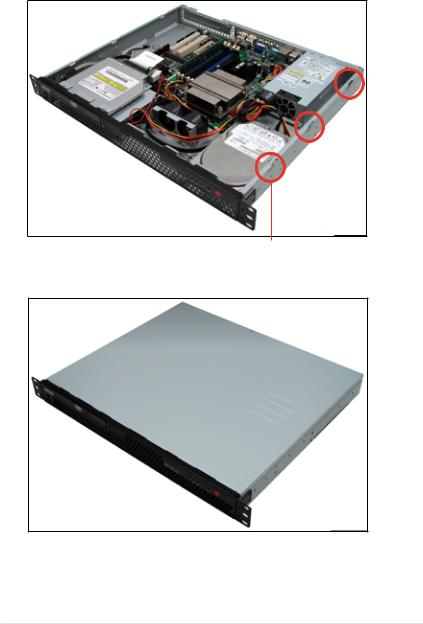
2.1.2Installing the cover
1.Position the cover on top of the chassis with the hooks aligned to the side tabs of the chassis.
Side tabs
2.Slide the cover toward the front until it snaps in place.
ASUS RS100-E5-PI2 |
2-3 |
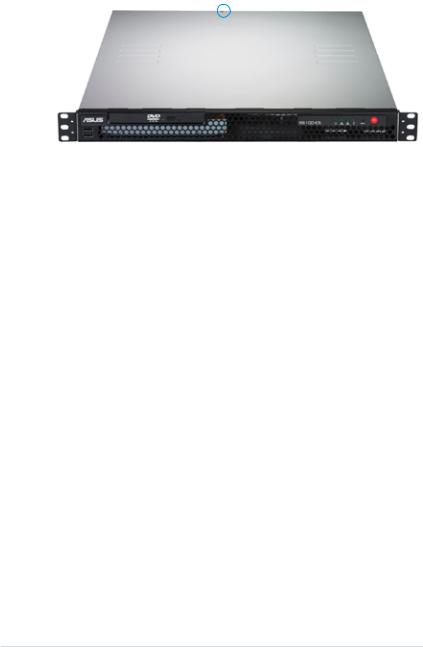
3.Secure the cover with one screw.
2-4 |
Chapter 2: Hardware setup |

2.2Motherboard information
Place eight (8) screws into the holes indicated by circles to secure the motherboard to the chassis.
Refer to Chapter 4: Motherboard Information for detailed Information.
Place this side towards |
P5BV-M/RS100-E5 |
the rear of the chassis |
|
Make sure to unplug the power cord before installing or removing the motherboard. Failure to do so can cause you physical injury and damage motherboard components.
ASUS RS100-E5-PI2 |
2-5 |
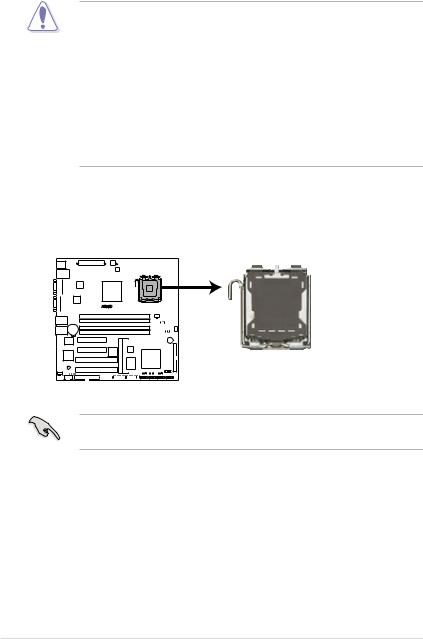
2.3Central Processing Unit (CPU)
The motherboard comes with a surface mount LGA775 socket designed for the Intel® Xeon® 3300/3200/3100/3000 series processors in the 775-land package.
•Upon purchase of the motherboard, make sure that the PnP cap is on
the socket and the socket contacts are not bent. Contact your retailer immediately if the PnP cap is missing, or if you see any damage to the PnP cap/socket contacts/motherboard components. ASUS shoulders the repair cost only if the damage is shipment/transit-related.
•Keep the cap after installing the motherboard. ASUS will process Return
Merchandise Authorization (RMA) requests only if the motherboard comes with the cap on the LGA775 socket.
•The product warranty does not cover damage to the socket contacts resulting from incorrect CPU installation/removal, or misplacement/loss/ incorrect removal of the PnP cap.
2.3.1Installing the CPU
To install a CPU:
1.Locate the CPU socket on the motherboard.
P5BV-M/RS100-E5 |
P5BV-M/RS100-E5 CPU Socket 775
Before installing the CPU, make sure that the cam box is facing towards you and the load lever is on your left.
2-6 |
Chapter 2: Hardware setup |

2.Press the load lever with your thumb (A), then move it to the left (B) until it is released from the retention tab.
Retention tab
A
Load lever
|
|
|
PnP cap |
B |
|
||
|
|
||
|
|
||
This side of the socket |
|||
|
|
box should face you. |
|
To prevent damage to the socket pins, do not remove the PnP cap unless you are installing a CPU.
3.Lift the load lever in the direction of the arrow to a 135º angle.
4.Lift the load plate with your thumb and forefinger to a 100º angle (A), then push the PnP cap from the load plate window to remove (B).
B
A
Load plate
5.Position the CPU over the socket, making sure that the gold triangle is on the bottom-left corner of the socket. The socket alignment key should fit into the CPU notch.
Alignment key
Gold triangle mark
ASUS RS100-E5-PI2 |
2-7 |
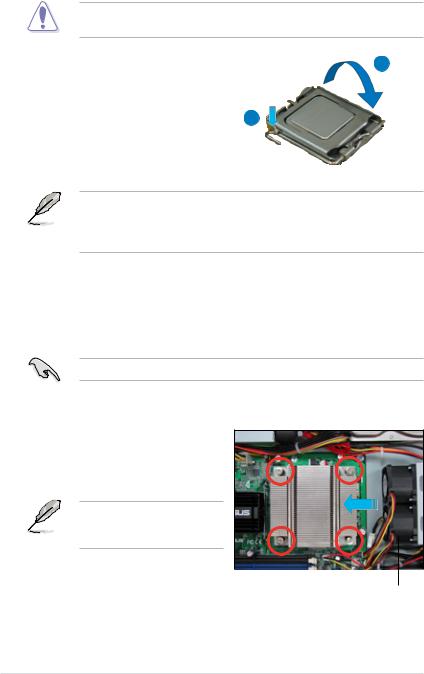
The CPU fits in only one correct orientation. DO NOT force the CPU into the socket to prevent bending the connectors on the socket and damaging the CPU!
6. Close the load plate (A), then A push the load lever (B) until it
snaps into the retention tab.
B
The motherboard supports Intel® Xeon® 3300/3200/3100/3000 series processors with the Intel® Enhanced Memory 64 Technology (EM64T), and Enhanced Intel SpeedStep® Technology (EIST). Refer to the Appendix for more information on these CPU features.
2.3.2Installing the CPU heatsink
The Intel® Xeon® 3300/3200/3100/3000 series processors require a specially designed heatsink and fan-duct to ensure optimum thermal condition and performance.
Use only qualified CPU heatsink assembly.
To install the CPU heatsink:
1.Place the heatsink on top of the installed CPU, matching the screw
holes with the heatsink standoffs.
Make sure that the heatsink grill is parallel to the nozzle of the chassis fans as shown.
|
|
|
|
|
Chassis fans |
|
|
|
Screws |
||
2-8 |
Chapter 2: Hardware setup |
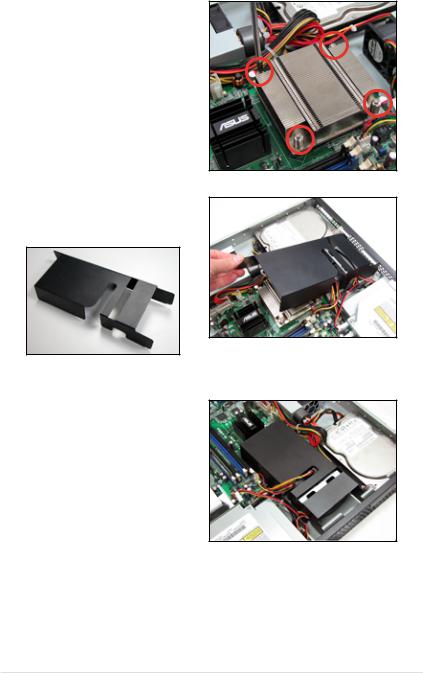
2.Tighten the screws.
3.Peel the adhesive cover of the heatsink plastic cover and evenly attach to heatsink.
Heatsink plastic cover
The heatsink plastic cover ensures the linear airflow between the heatsink and chassis fans.
ASUS RS100-E5-PI2 |
2-9 |
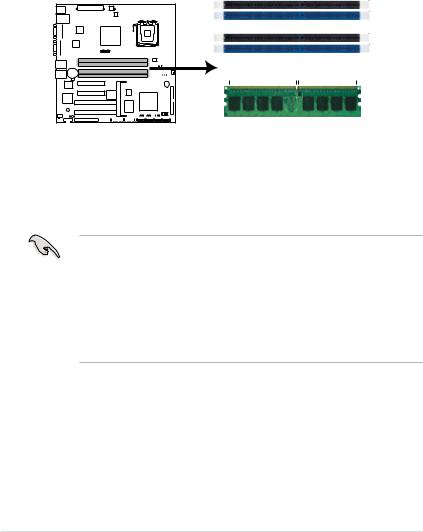
2.4System memory
2.4.1Overview
The motherboard comes with four Double Data Rate 2 (DDR2) Dual Inline Memory
Modules (DIMM) sockets.
A DDR2 module has the same physical dimensions as a DDR DIMM but has a 240-pin footprint compared to the 184-pin DDR DIMM. DDR2 DIMMs are notched differently to prevent installation on a DDR DIMM socket.
The figure illustrates the location of the DDR2 DIMM sockets:
P5BV-M/RS100-E5 |
DIMM_A1
DIMM_A2
DIMM_B1
DIMM_B2
128 Pins |
112 Pins |
|||||
|
|
|
|
|
|
|
P5BV-M/RS100-E5 240-pin DDR2 DIMM Sockets
2.4.2Memory configurations
You may install 512 MB, 1 GB, and 2 GB unbuffered ECC or non ECC DDR2-533/667 DIMMs into the DIMM sockets.
• Always install DIMMs with the same CAS latency. For optimum compatibility, we recommend that you obtain memory modules from the same vendor. Refer to the DDR2 Qualified Vendors List on the ASUS web site.
•When installing one or two DIMMs, install the DIMM(s) to the blue slots
(DIMM_A1/DIMM_B1).
•Three DDR2 DIMMs intalled into any three memory sockets will function in single-channel mode.
2-10 |
Chapter 2: Hardware setup |
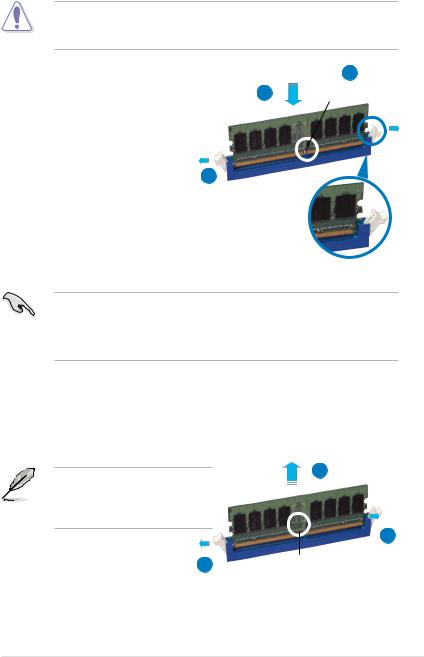
2.4.3Installing a DIMM
Unplug the power supply before adding or removing DIMMs or other system components. Failure to do so can cause severe damage to both the motherboard and the components.
To install a DIMM: |
|
2 |
|
1. |
Unlock a DIMM socket by pressing |
3 |
DDR2 DIMM notch |
|
|
||
|
the retaining clips outward. |
|
|
2. |
Align a DIMM on the socket |
|
|
|
such that the notch on the DIMM |
|
|
|
matches the break on the socket. |
1 |
|
3. |
Firmly insert the DIMM into the |
|
|
|
|
||
socket until the retaining clips snap back in place and the DIMM is properly seated.
Unlocked retaining clip
•A DDR2 DIMM is keyed with a notch so that it fits in only one direction. DO
NOT force a DIMM into a socket to avoid damaging the DIMM.
•The DDR2 DIMM sockets do not support DDR DIMMs. DO NOT install DDR DIMMs to the DDR2 DIMM sockets.
2.4.4Removing a DIMM
Follow these steps to remove a DIMM.
1.Simultaneously press the retaining clips outward to unlock the DIMM.
Support the DIMM lightly with your fingers when pressing the retaining clips. The DIMM might get damaged when it flips out with extra force.
1
2.Remove the DIMM from the socket.
2
1
DDR2 DIMM notch
ASUS RS100-E5-PI2 |
2-11 |
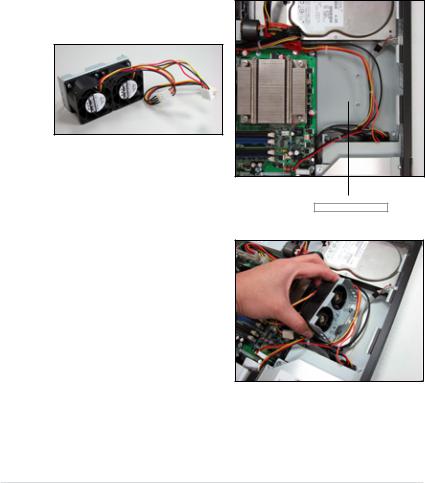
2.5Replaceable components
You may need to replace defective components or remove previously installed system components when installing or removing system devices. This section tells how to install or remove the following components:
1.Chassis fans
2.Serial ATA hard disk drives
3.Optical disk drive
2.5.1Installing the chassis fans
To install the chassis fans:
1.Locate the chassis fan plate on the chassis.
Chassis fans
Chassis fan plate
2.Insert the chassis fans into the fan plate.
2-12 |
Chapter 2: Hardware setup |
